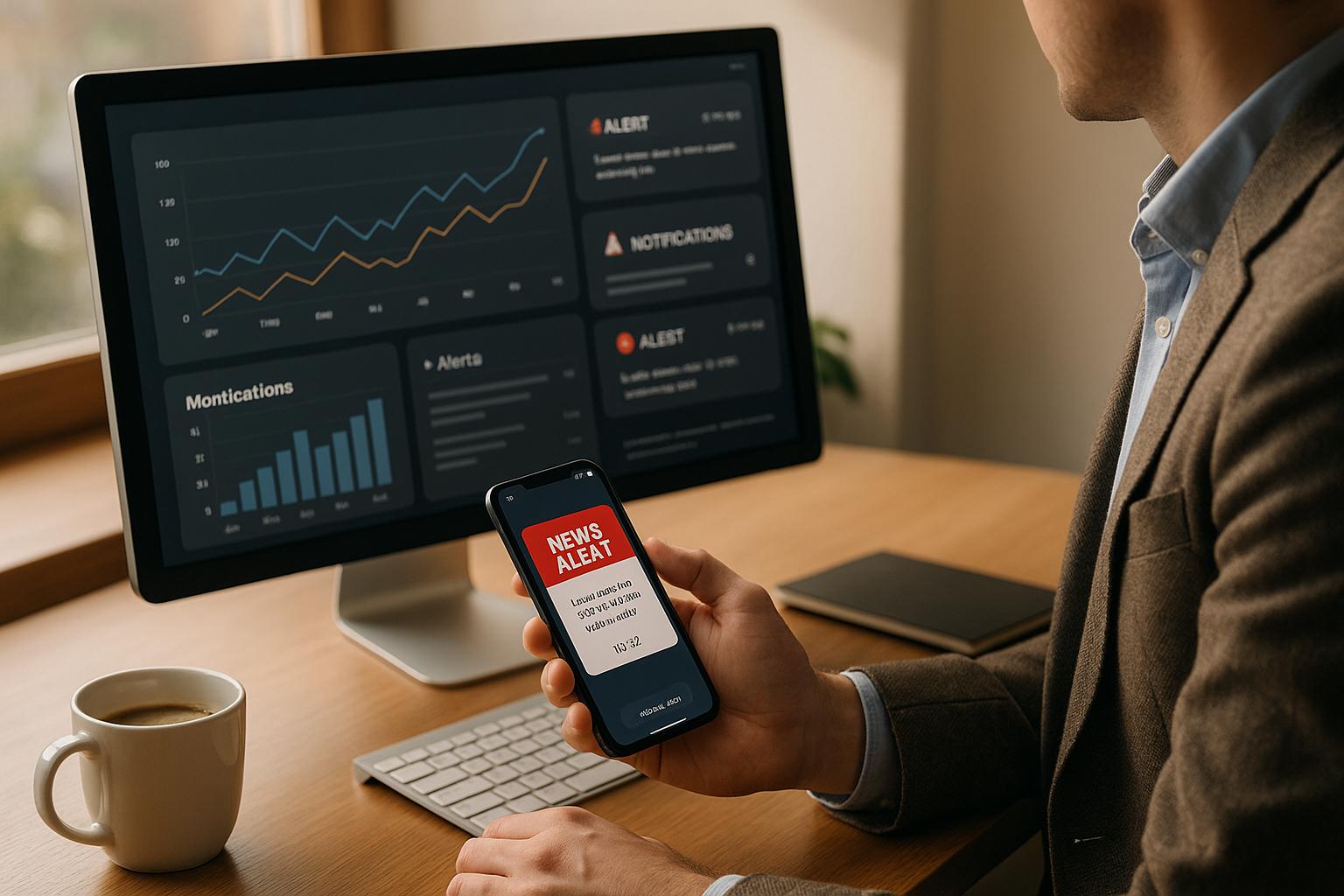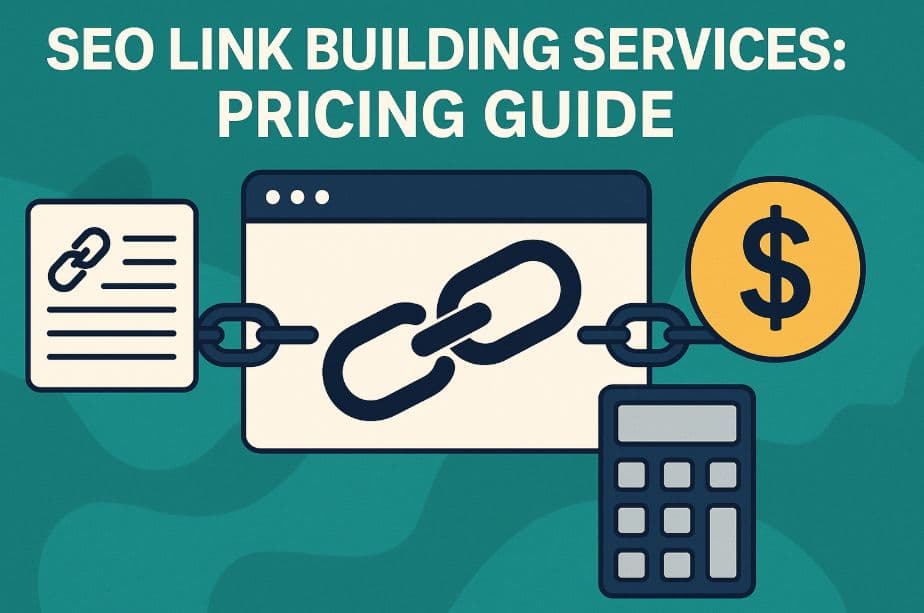In 2025, AI tools are transforming how businesses handle crises, offering faster detection, real-time monitoring, and automated responses. These platforms analyze massive data from social media, news, and alerts to help organizations respond quickly and effectively. Key benefits include identifying crises up to three days earlier, improving response times by 30%, and boosting customer satisfaction by 25%. Here are the top 7 AI tools for crisis communication:
- Talkwalker: Real-time monitoring, sentiment analysis, and automated alerts for social media and news.
- Meltwater: Comprehensive media monitoring with sentiment tracking across 242 languages.
- Cision: Media monitoring and journalist outreach with advanced sentiment analysis.
- Konexus: Emergency notifications and incident management tailored for public safety.
- Brand24: Affordable social media monitoring with sentiment and anomaly detection.
- ClickUp AI: Task management with AI-driven alerts and real-time project updates.
- Noggin: All-in-one crisis management platform with real-time data integration.
Quick Comparison:
| Tool | Key Features | Best For | Pricing |
|---|---|---|---|
| Talkwalker | Social listening, sentiment analysis | Large enterprises | Custom (enterprise-focused) |
| Meltwater | Media monitoring, influencer tracking | PR teams, global organizations | ~$3,000/month |
| Cision | Journalist database, crisis templates | PR agencies, media-centric teams | $5,000/year |
| Konexus | Emergency alerts, incident management | Schools, government agencies | Custom |
| Brand24 | Social media monitoring, alerts | Small to medium businesses | Starts at $79/month |
| ClickUp AI | Task automation, project collaboration | Teams needing workflow integration | $7/user/month for AI |
| Noggin | Crisis management, real-time monitoring | Large organizations | Custom (enterprise-level) |
Each tool offers unique features tailored to specific needs. Small businesses can opt for Brand24 or ClickUp AI for affordability, while large enterprises may benefit from Talkwalker, Meltwater, or Noggin for comprehensive solutions. For public sector emergencies, Konexus stands out.
AI tools are no longer optional - they're essential for faster, smarter crisis management in today's digital world.
How to Use AI for Crisis Management | Sprinklr
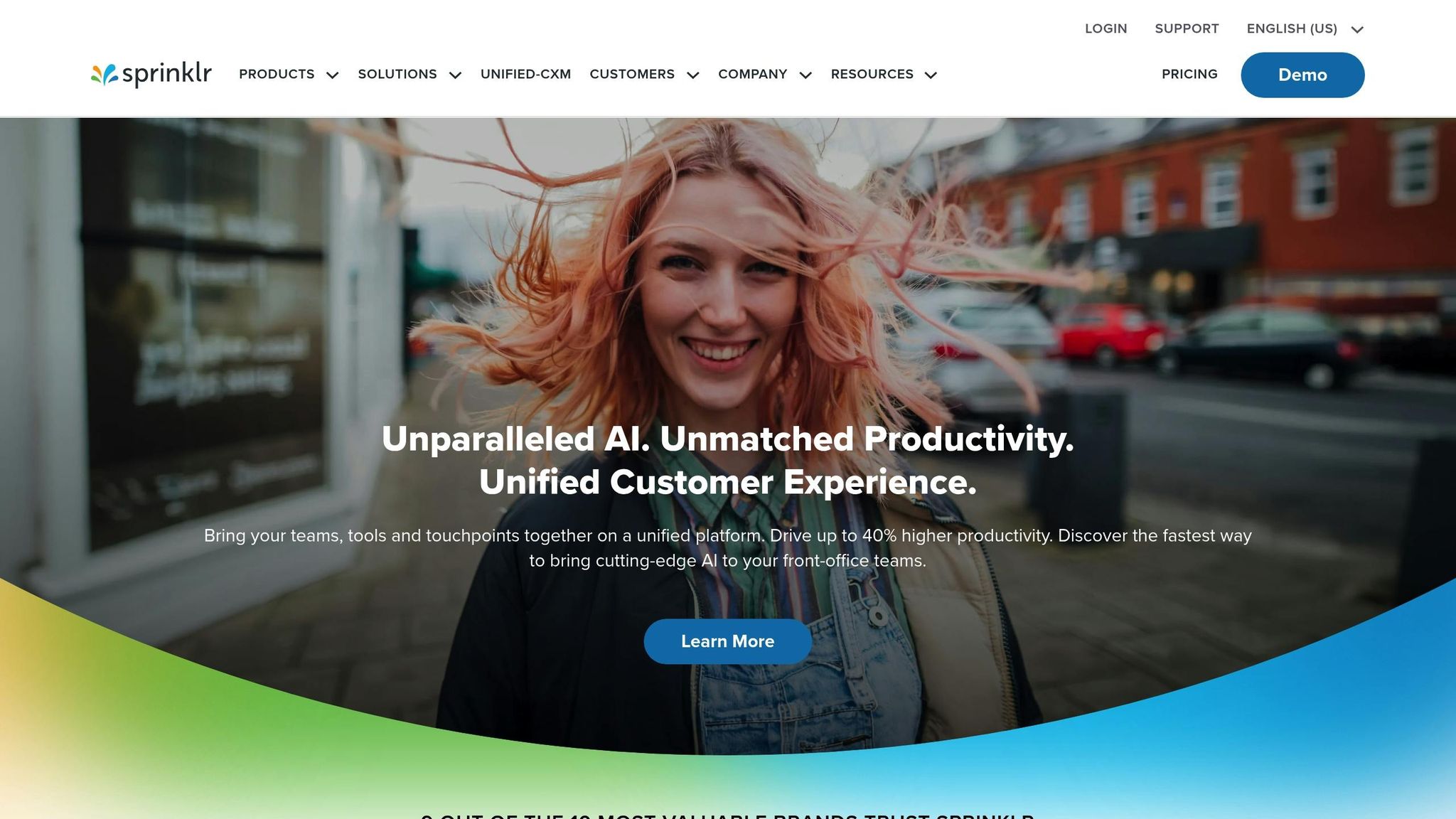
1. Talkwalker
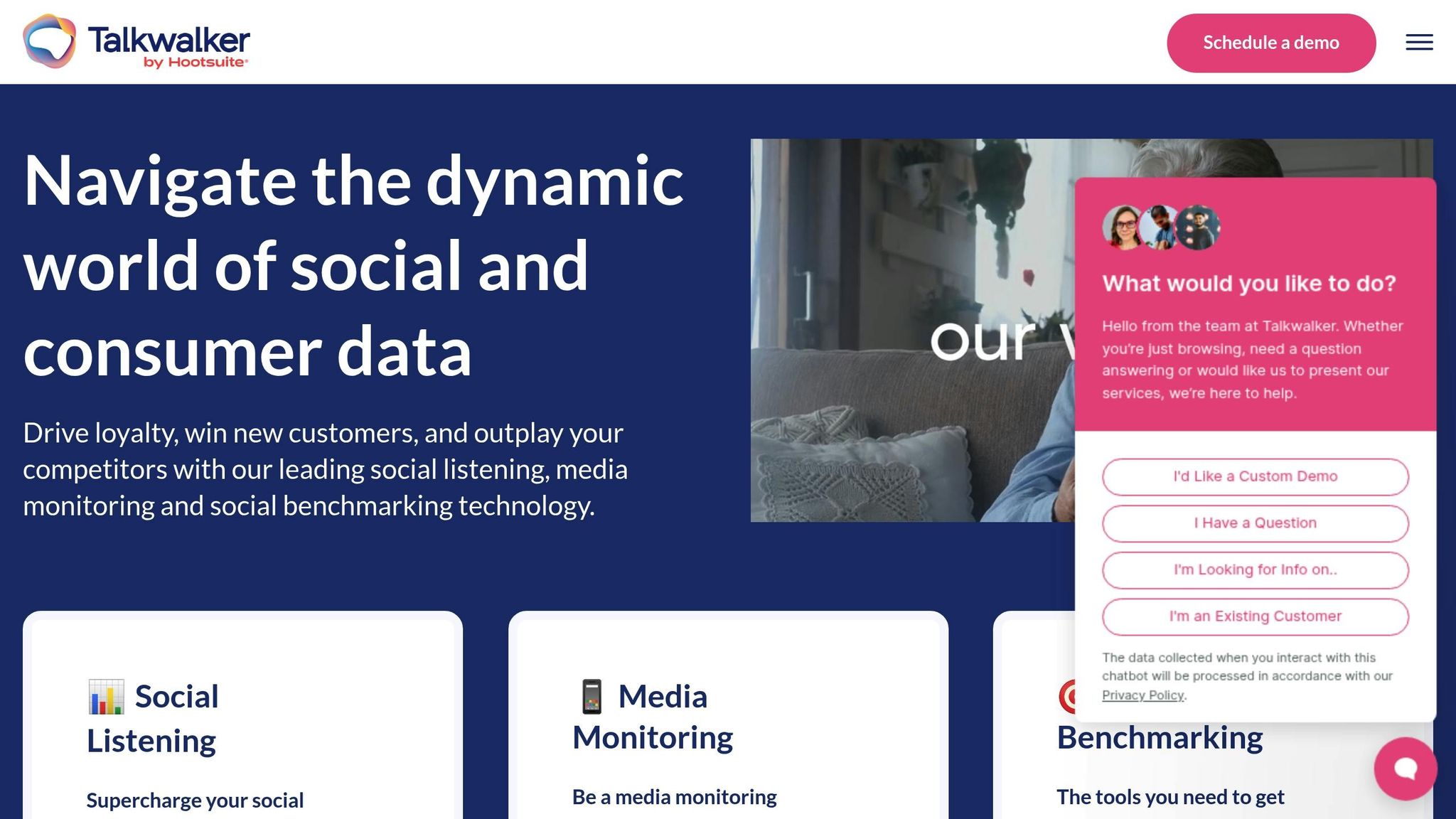
Talkwalker is a tool powered by AI that helps businesses handle crisis communication effectively. It combines real-time monitoring, sentiment analysis, and automated alerts to provide insights that can guide organizations during critical moments. By analyzing data from social media, news outlets, and other online sources, Talkwalker helps companies stay informed and prepared.
Real-time Monitoring
One of Talkwalker’s standout features is its ability to track brand mentions and sentiment globally in real-time. It keeps an eye on social media platforms and other channels, helping organizations spot potential issues before they escalate. For example, it can track specific hashtags or conversations that could become central during a crisis.
The platform’s ability to capture multi-channel conversations instantly can be a game changer. When Delta Connection Flight 4819 faced a major incident on February 17, 2025, similar monitoring systems helped track public responses quickly, allowing for swift adjustments to strategy.
"Quick Search provides such an easy and user-friendly opportunity to deep dive into your competitors' social sphere; letting you harness their strengths and weaknesses to improve and cultivate a winning marketing strategy." - Christina Garnett, Community + Advocacy @HubSpot
Sentiment Analysis
Talkwalker’s sentiment analysis goes beyond just identifying positive or negative reactions. With an impressive 90% accuracy across more than 127 languages, it can pick up subtle nuances, even detecting sarcasm.
For instance, during a chili pepper shortage, the tool revealed that consumers were more sad about missing their favorite Sriracha sauce than angry at the brand. This insight helped the company shape a more empathetic response strategy. Additionally, brands can filter comments based on the severity of negativity, which makes it easier to prioritize responses and prevent small issues from spiraling into PR disasters.
When Gucci launched the Gucci Gaming Academy in partnership with FACEIT in May 2022, Talkwalker’s sentiment analysis showed that the initiative’s focus on mental and physical health generated 34% positive sentiment around the launch.
Automated Alerts
Talkwalker’s automated alert system acts as an early warning tool, customizable for different crisis scenarios. Organizations can set up alerts to monitor spikes in mentions, shifts in sentiment, or sudden increases in negative comments. These alerts are especially useful for catching problems early, such as when negative sentiment overtakes positive feedback or industry rumors begin to circulate.
The platform recommends setting alerts for a 20% drop in sentiment to flag potential problems before they grow. This system ensures that brands can respond quickly and effectively to emerging risks.
"Talkwalker adds sentiment information to all results, from online reviews to news articles, social media to survey responses. Enabling you to manage risks with a technology that flags high risk posts in real time." - Talkwalker
Crisis Response Capabilities
Talkwalker helps businesses shift from reacting to crises to proactively managing them. By delivering data that highlights risks and weak points in the customer journey, it enables organizations to address problems before they escalate.
For example, Alfred Coffee implemented a 30-minute comment review protocol using similar monitoring tools, cutting their response time in half. This kind of quick action is crucial, especially when 68% of brands experience reputation damage due to poorly handled online incidents.
Additionally, Talkwalker allows brands to amplify positive conversations while addressing negative ones. This dual approach not only helps mitigate harm but also leverages user-generated content for marketing during and after a crisis. By balancing these strategies, businesses can maintain steady communication even in challenging times.
2. Meltwater
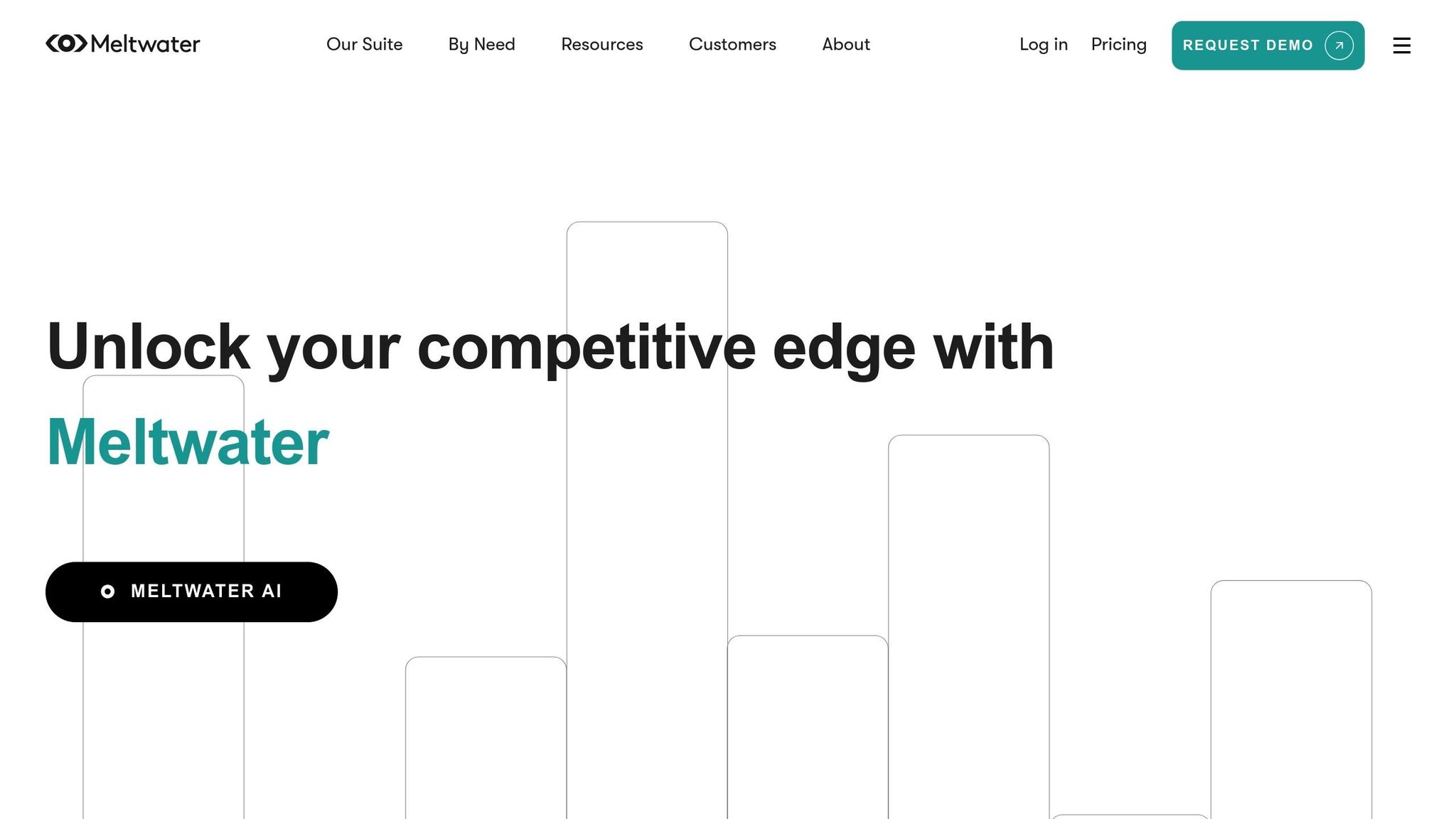
Meltwater is an AI-driven platform designed to handle crisis communication through real-time monitoring and analysis. It helps organizations detect potential issues early and respond quickly, aligning perfectly with the proactive crisis management strategies expected in 2025. By analyzing billions of data points across online and offline channels, Meltwater lays the groundwork for effective crisis management across multiple platforms.
Real-time Monitoring
Meltwater scans over 270,000 global sources in real time, processing an impressive 500 million pieces of content daily. This extensive reach allows organizations to identify potential crises as they start to gain traction, rather than waiting for problems to escalate into major disasters.
For example, during the Tiger Woods car accident crisis, Tripepi Smith used Meltwater's keyword search and Spike Detection Alerts to track news and social media discussions, enabling them to stay ahead of the story.
Meltwater also empowers brands to engage in social conversations as they unfold, giving them the ability to address potential issues before they spiral out of control.
"Meltwater helps us understand our reach and assess the effect a negative article could have on our visitors. Receiving real-time alerts allows us to stay in front of potentially damaging stories, tell our story and reshape the conversation."
- Christy Chachere, Communications Specialist, Visit Baton Rouge
This constant monitoring feeds directly into Meltwater's sentiment analysis, offering a deeper understanding of public opinion.
Sentiment Analysis
Meltwater's AI-powered sentiment analysis tracks brand perception across numerous channels, offering critical insights during crises. Supporting 242 languages, with detailed sentiment analysis for 218 of them, the platform is particularly useful for global organizations. It helps teams identify what’s driving discussions, spot emerging issues, and monitor changes in public sentiment as crises unfold.
An upgraded English-language sentiment model further enhances the accuracy of its monitoring, ensuring reliable data for decision-making during high-pressure situations.
Automated Alerts
Meltwater's Smart Alerts provide customizable notifications tailored to various crisis scenarios. Users can choose from several alert types, including Spike Detection, Company Events, Industry Events, Sentiment Shifts, and Every Mention alerts. For Spike Detection, users can adjust sensitivity levels to control how often they’re notified.
For instance, if social mentions jump from 200 to 500 on a Saturday afternoon, a Spike Detection alert is triggered. Alerts are sent through multiple channels - email, web notifications, mobile apps, Slack, Teams, DingTalk, or Generic Webhook. To avoid information overload, "Every Mention" alerts are capped at 200 per hour.
Crisis Response Capabilities
Meltwater doesn’t just stop at monitoring - it transforms insights into actionable steps. Its AI tools allow users to quickly identify discussion trends and assess whether a situation requires immediate action. This rapid analysis enables crisis teams to make informed decisions about how to proceed.
As Fran Wood, Customer Service Director at Detroit Metro Airport, shares:
"I'm so confident now that I won't miss an alert that I can relax more during my off-hours. Meltwater has given us back the freedom to enjoy our home lives."
- Fran Wood, Detroit Metro Airport
Organizations can also track key metrics like sudden sentiment changes or spikes in engagement on owned social channels, which often act as early warning signs of a developing crisis. By delivering timely and actionable insights, Meltwater supports quick, strategic responses to emerging issues.
3. Cision
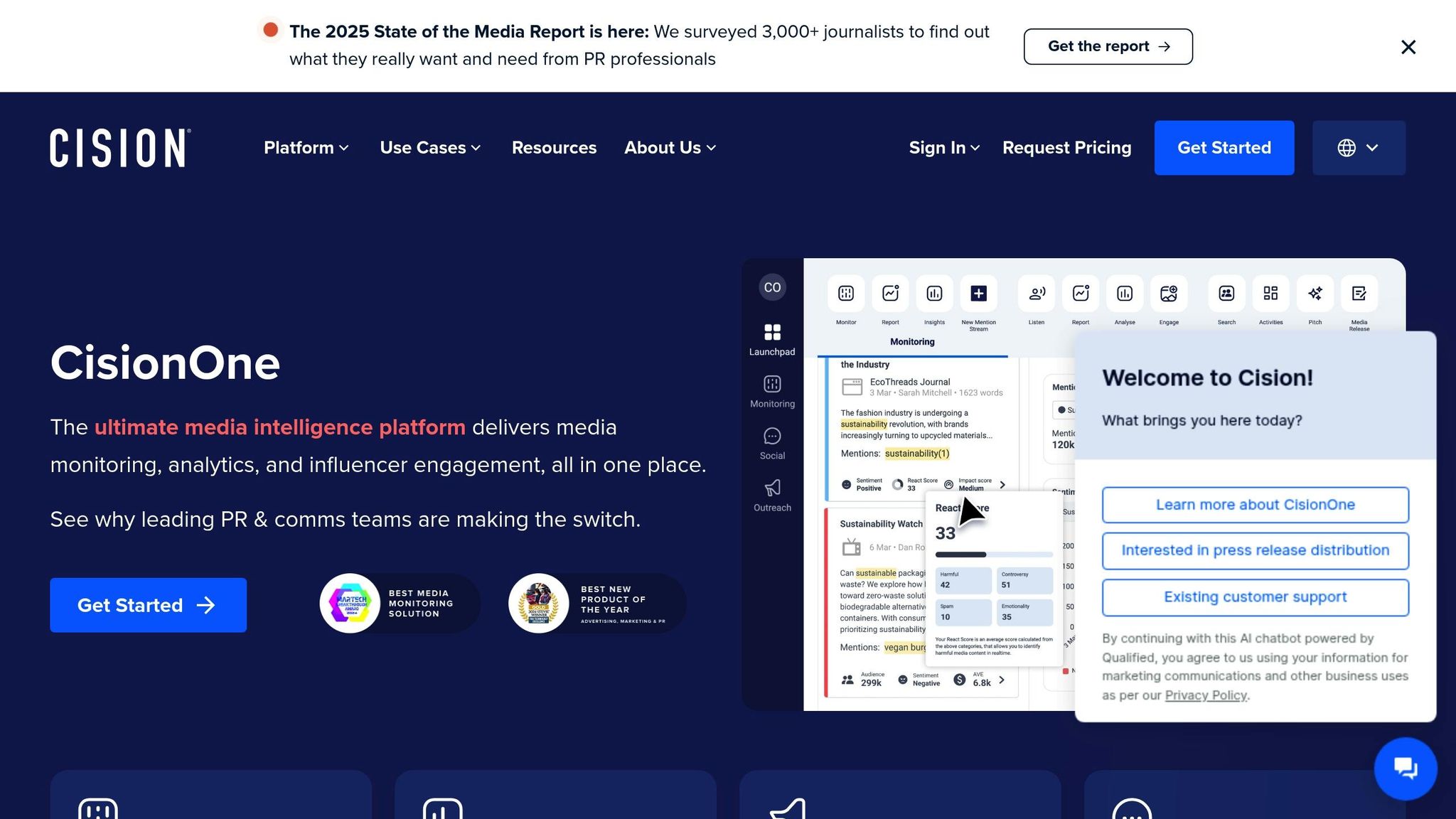
Cision is an AI-powered platform designed to bolster crisis communication through advanced monitoring and response tools. With only 31% of communications leaders confident in identifying emerging crises, Cision's CisionOne platform steps in to bridge this gap by delivering real-time insights across a variety of media channels.
By analyzing data from sources like websites, social media, TV, and print, the platform identifies shifting narratives as they develop. This comprehensive coverage is crucial in today’s fast-paced environment, where crises can quickly gain traction across multiple platforms. Beyond monitoring, Cision equips users with tools to anticipate and address potential issues before they escalate.
Real-time Monitoring
Cision’s real-time monitoring acts as a safeguard against escalating situations. The platform tracks mentions of brands, competitors, industry trends, and specific keywords across all types of media. Using its AI-powered React Score, CisionOne flags potentially harmful content as it surfaces, giving teams the ability to evaluate risks early. Alerts notify users of keyword spikes and highlight emerging misinformation, enabling swift action.
A great example of this is California Pizza Kitchen’s response to a TikTok crisis in July 2024. By detecting the issue early, the company turned a potential PR disaster into a positive moment by responding with a care package, a voucher, and a lighthearted chef video.
Sentiment Analysis
Once potential threats are detected, Cision’s sentiment analysis adds another layer of insight. The platform evaluates content from both social and traditional media - including paywalled sources - using five sentiment categories: Positive, Trending Positive, Balanced, Trending Negative, and Negative. The React Score goes further by assessing the emotional intensity, controversy, or potential harm of content, helping teams grasp not just what’s being said but the tone and intent behind it.
"Knowing the volume of coverage is important, but Cision gave us the ability to gauge sentiment, which is key to delivering campaign results to our senior leadership." - Fergus Campbell, Head of Communications Services, Gumtree
This feature has proven invaluable during high-profile crises. For instance, when Volkswagen faced a recall of 260,000 vehicles due to fuel tank issues in 2024, the sentiment analysis helped the company monitor public reactions and craft reassuring messages, emphasizing that repairs would be provided at no cost. Real-time alerts further ensured the team stayed updated as the situation unfolded.
Automated Alerts
Cision’s automated alert system allows organizations to stay ahead of potential issues with customizable Mention Streams. These alerts can be tailored to specific scenarios, triggering instant notifications when relevant news or updates arise. The platform supports unlimited keyword monitoring and offers filtering options by location and language. Users can also schedule reports and configure alerts to match their team’s response protocols, customizing everything from content and format to timing and recipients.
Crisis Response Capabilities
Cision doesn’t just stop at monitoring - it helps turn insights into actionable strategies. Its brand reputation management tools enable teams to respond quickly and effectively during emergencies. The platform facilitates direct communication with journalists and influencers, providing crisis teams with the resources to shape narratives and share critical insights. Additionally, custom dashboards with real-time data and configurable widgets can be created specifically for crisis response efforts.
This integrated approach has delivered results. For example, when Adidas ended its seven-year partnership with Kanye West over anti-Semitic remarks, Cision’s tools helped the company manage the fallout and maintain control over the narrative.
4. Konexus
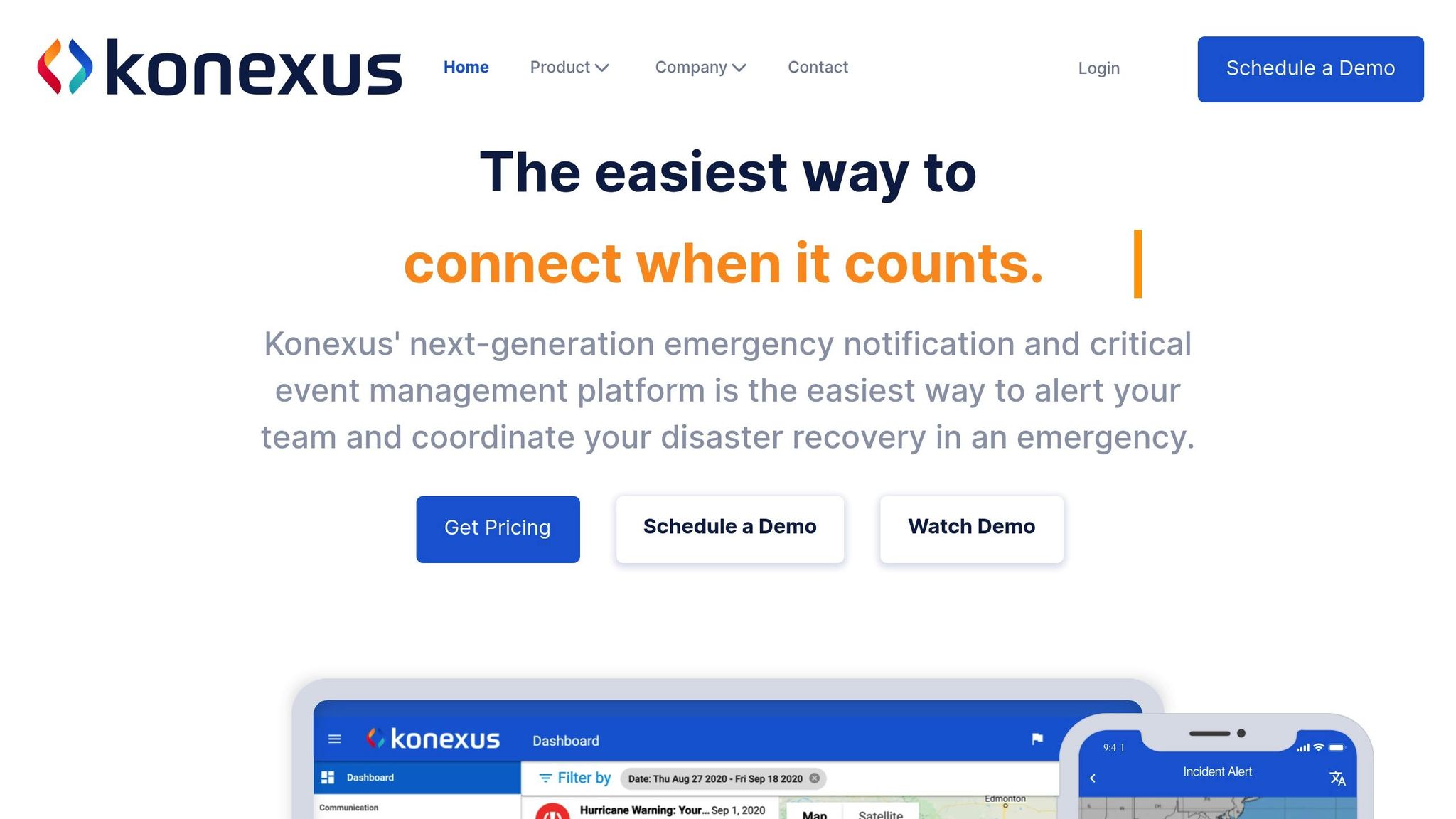
Konexus is an emergency notification and crisis management platform built to streamline communication during critical situations. With a flawless 5.0/5 rating for real-time notifications and 100% positive user reviews, it’s a trusted tool for organizations that need dependable performance when it counts most. This section highlights its powerful alerting and crisis response features.
Real-time Monitoring
Konexus provides global real-time monitoring, connecting teams and facilities no matter where they are. It integrates notifications from the National Weather Service to supply up-to-the-minute weather updates during emergencies. Even in cases of lost connectivity, its mobile apps ensure uninterrupted access to continuity plans. Users can track response progress in real time through both the platform and its app, while integrations with tools like Slack and Microsoft Teams make collaboration during high-pressure situations more efficient.
Automated Alerts
Konexus enhances its monitoring capabilities with a robust, multi-channel alert system. Automated notifications are sent through various channels - mobile push, email, SMS, voice, and even fax - ensuring critical messages reach recipients on their preferred devices. Organizations can tailor alert rules and delivery methods to suit different crisis scenarios. For instance, in the event of a fire, the platform can automatically send evacuation alerts to all employees, ensuring timely communication.
Crisis Response Capabilities
Beyond detection, Konexus simplifies the process of managing crises. It offers tools to evaluate incident severity, assign tasks, and ensure every critical action is covered. The mobile app centralizes essential features, allowing users to notify employees, distribute task lists, and even conduct polls directly from the scene. With in-stream translation supporting over 100 languages, it’s especially effective in diverse communities. For example, during Hurricane Irma, this feature proved vital for communicating with 1.9 million Spanish-speaking residents. The Incident Guide (or Incident Pocket Guide in the mobile app) serves as a one-stop resource for safety procedures, evacuation maps, and business continuity plans.
"Best notification system out there" - Russ T., Public Safety
Konexus also supports post-crisis evaluations by helping organizations review their responses, refine emergency plans, and identify areas for improvement.
sbb-itb-3230277
5. Brand24
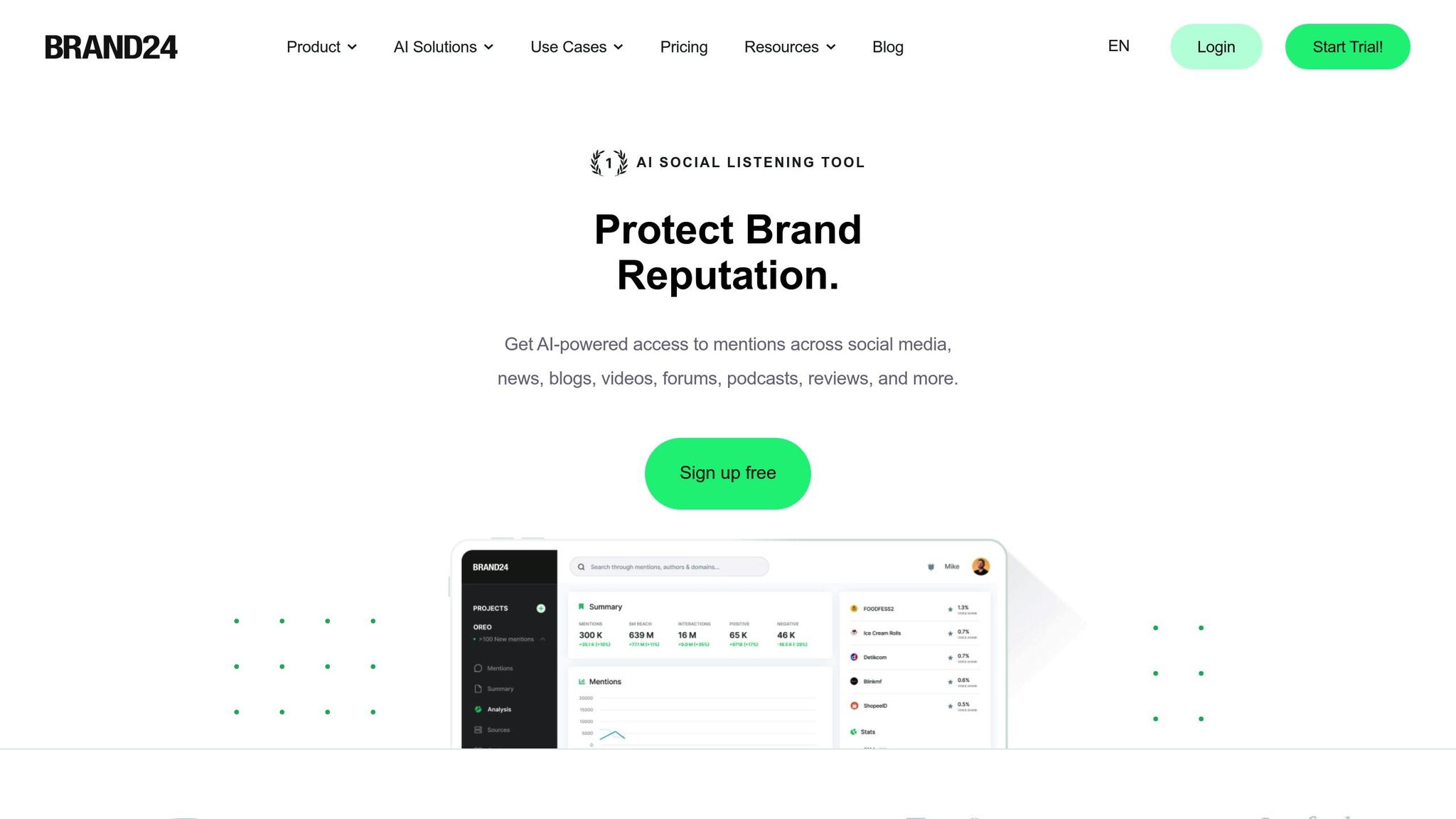
Brand24 is a social media monitoring tool designed to track online reputation and detect potential crises before they escalate. Starting at $149 per month (billed annually) and offering a 14-day free trial, it provides extensive monitoring across 25 million channels, delivering insights from over 25 billion mentions.
Real-time Monitoring
Brand24 keeps an eye on 25 million channels - including social media, news outlets, blogs, reviews, videos, podcasts, and forums - ensuring comprehensive coverage of brand-related conversations. It captures both tagged and untagged mentions, sending instant alerts via Slack, email, or in-app notifications to keep users informed of emerging issues. Its Storm Alerts notify users of sudden spikes in mention volume or social media reach, while its anomaly detector differentiates between routine changes and potential threats. Additionally, trends analysis helps businesses spot early warning signs by examining shifts in mentions and sentiment.
Sentiment Analysis
Brand24 enhances its monitoring capabilities with AI-driven sentiment analysis, categorizing mentions as positive, negative, or neutral. This feature enables businesses to address concerns promptly. In 2024, its machine learning models achieved an 85% accuracy rate in sentiment detection, improving the ability to respond to negative feedback in real time by 30%. The platform also offers emotion and topic analysis, identifying specific emotions and themes that may contribute to negative sentiment. For instance, during the February 2023 premiere of Ant-Man and the Wasp: Quantumania, Brand24 detected negative feedback that impacted Marvel's reputation. The Compare Periods feature allows users to track key metrics over time, aiding in early crisis detection. Studies show that leveraging sentiment analysis in crisis management can reduce the negative impact of a crisis by up to 40%.
Automated Alerts
Brand24’s automated alert system ensures teams never miss critical mentions. These media alerts notify users when specific keywords are mentioned across various platforms, enabling swift responses to influence discussions and shape public perception. Alerts can be tailored based on keywords, sentiment, source, and even country of origin or interaction levels. Additional filters for visit counts, dates, and mention thresholds provide further customization.
"Useful tool for tracking mentions & staying up-to-date. I love e-mail alerts that give me the possibility to stay up-to-date without even logging in to the app."
- Aleksandra Holownia, Marketing Manager at Dealavo
Storm Alerts focus on significant increases in mention volume or reach, acting as an early warning system for potential crises. The anomaly detector not only flags unexpected spikes but also explains their underlying causes.
Crisis Response Capabilities
In the event of a crisis, Brand24 offers real-time conversation tracking and filters earned media channels, enabling teams to monitor developments and respond to changing sentiment quickly. By combining sentiment analysis with mention volume, the platform creates a powerful tool for identifying emerging PR challenges. Filters allow teams to focus on the most impactful channels, ensuring their resources are directed where they matter most.
"Brand24 allows us to check the results daily, so we are always up to date and can react in any situation."
- Aleksandra Samek, Head of Marketing at Marken
These features make Brand24 especially valuable for businesses in PR, marketing, and event planning. Its ability to provide instant insights and preempt negative sentiment ensures teams can intervene before issues spiral out of control. Tools like Brand24 are shaping the future of crisis management, offering businesses a proactive approach to safeguarding their reputation in 2025.
6. ClickUp AI
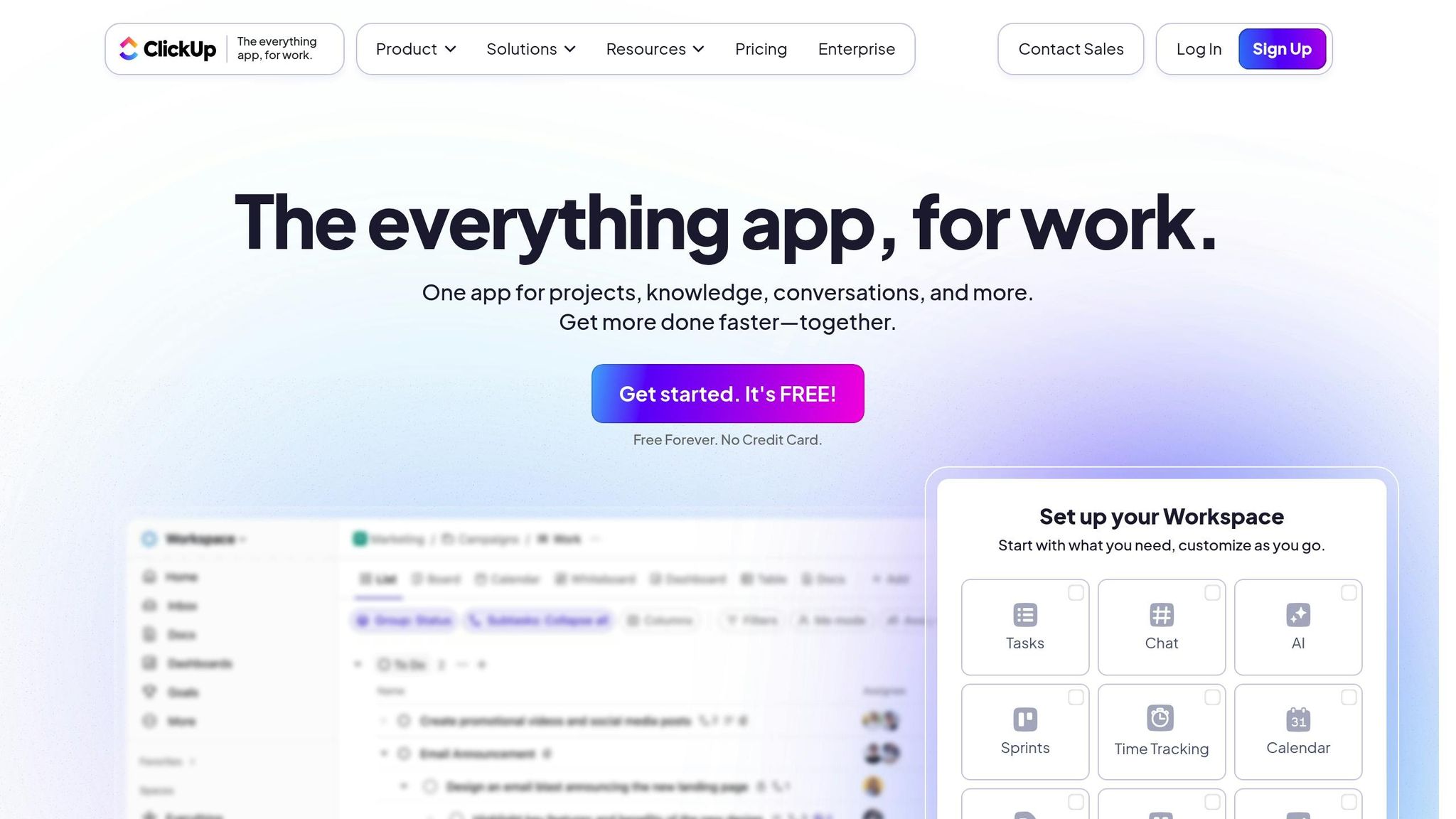
ClickUp AI stands out by seamlessly combining project management with crisis communication. Powered by ClickUp Brain, this platform integrates project data directly into crisis management workflows. It doesn't just handle tasks - it delivers real-time insights from project activities, making it a go-to solution for teams needing immediate updates during a crisis.
Real-time Monitoring
ClickUp Brain offers instant insights by continuously scanning live task updates and summarizing key activities. For instance, if a developer marks a critical feature as "in progress" or a PR manager uploads new crisis materials, the AI captures and highlights these changes. Its Autopilot Agents actively monitor workspace activity, flagging overdue tasks and even suggesting rescheduling. Meanwhile, its Dashboard integration delivers up-to-the-minute project metrics, eliminating the delays caused by manual updates. This ensures every team member remains on the same page during high-pressure situations.
Automated Alerts
Using natural language processing, ClickUp AI flags potential issues, creates follow-up subtasks, and sends automatic notifications to relevant team members . Teams can customize Autopilot Agents to respond to specific triggers, like alerting stakeholders when a task's status changes to "complete" during a crisis workflow.
Crisis Response Capabilities
ClickUp AI doesn’t just track and alert - it actively supports crisis response. It can transcribe discussions, summarize conversation threads, and assign action items to ensure seamless coordination. The platform also includes tools for building crisis plans, offering customizable templates and risk matrices tailored to an organization’s needs .
Mike Coombe from MCM Agency shares his experience:
"With the addition of ClickUp AI, I'm more efficient than ever! It saves me 3x the amount of time spent previously on Project Management tasks. Not only has it enhanced my productivity, but it has also ignited my creativity."
ClickUp Brain’s contextual intelligence allows team members to access real-time answers by analyzing current task statuses, recent comments, and attached documents. This ensures decisions are made using the most up-to-date information. Key crisis management features - like real-time social media monitoring, automated sentiment analysis, AI-powered chatbots, and predictive analytics - help teams anticipate and tackle potential issues. These tools have led to a 50% reduction in meetings and a 30% boost in productivity, saving mid-market companies around $94K annually . With these capabilities, ClickUp AI has become an essential tool in the AI-driven crisis communication landscape.
7. Noggin
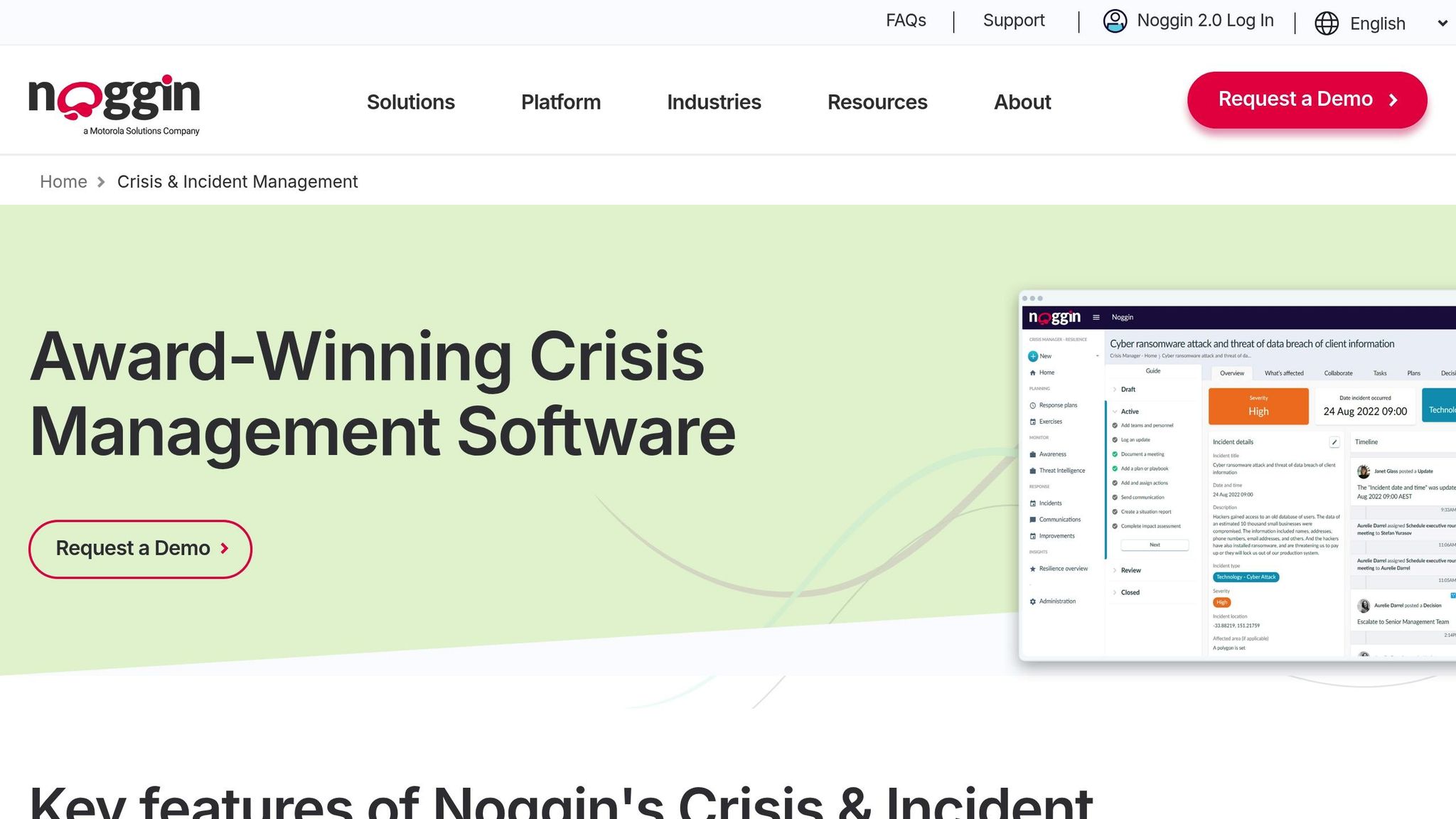
Noggin is part of Motorola's "Solving for Safer" ecosystem, offering an all-in-one platform for managing crises. It integrates monitoring, response, and automation to anticipate and handle emergencies effectively. By combining risk, resilience, continuity, security, and incident management, Noggin provides a seamless solution for organizations facing various challenges.
Real-time Monitoring
Noggin enhances situational awareness through custom dashboards that pull together live maps and data feeds. These dashboards consolidate information from news outlets, weather reports, social media, traffic updates, and disaster alerts, giving users a comprehensive view of ongoing events. Additionally, the platform can monitor critical infrastructure like security cameras, access control systems, and communication devices. Thanks to its integration with Motorola's surveillance and communication tools, users get a unified perspective on operations and device status. Whether dealing with natural disasters, cybersecurity incidents, or facility-related issues, Noggin’s interactive maps and real-time visualizations ensure no detail is missed.
Automated Alerts
Noggin’s notification system ensures critical information reaches the right people at the right time. Using customizable workflows, alerts are triggered based on incident type or severity. Notifications can be sent via SMS, email, voice calls, or app alerts, and the platform’s targeting features allow messages to be directed to specific teams, roles, or locations. To ensure no alert goes unnoticed, Noggin includes acknowledgment tracking, which escalates messages if responses aren’t received within a set timeframe. These automated alerts complement the platform’s monitoring capabilities, making crisis response more efficient.
Crisis Response Capabilities
Noggin’s tools are designed to streamline collaboration and communication during crises, helping organizations restore normal operations as quickly as possible. Its features include:
- Incident Management: Users can report incidents, automate notifications, activate response teams, assign tasks, record decisions, and share updates - all from one system.
- Team Activation & Collaboration: Response teams are notified instantly and can communicate through dedicated chat groups.
- Crisis Communications: Real-time updates and coordination are possible via chat, email, SMS, voice, or app push notifications.
- Response Planning: Organizations can create customizable crisis response plans based on established best practices.
- Analytics & Reporting: The platform tracks trends, visualizes key metrics, and conducts post-incident reviews to improve future preparedness.
Noggin’s integrated approach ensures that organizations are not only equipped to handle crises but also to learn and adapt, strengthening their ability to face future challenges.
Tool Comparison Chart
Selecting the right AI tool for crisis communication hinges on your specific needs, budget, and operational scale. Below is a breakdown of seven top platforms, highlighting their features, pricing, strengths, and limitations to help you make an informed decision.
| Tool Name | Key Features | Pricing | Strengths | Limitations | Best Use Case |
|---|---|---|---|---|---|
| Talkwalker | Social listening, sentiment analysis, real-time monitoring, automated alerts | Custom pricing (enterprise-focused) | Advanced analytics, global coverage, strong social media monitoring | Higher cost, complex setup for smaller teams | Large enterprises requiring extensive social media monitoring |
| Meltwater | Media monitoring, influencer tracking, crisis detection, analytics dashboard | Custom pricing starting ~$3,000/month | Comprehensive media database, strong analytics, well-established reputation | Expensive for SMBs, steep learning curve | Mid to large organizations with dedicated PR teams |
| Cision | Press release distribution, media monitoring, journalist database, crisis templates | Plans start at $5,000/year | Broad media contacts, integrated PR workflow, crisis templates | High cost, interface may overwhelm beginners | PR agencies and large corporations managing media relations |
| Konexus | Emergency notifications, mass communication, incident management, automated alerts | Custom pricing based on user count | Tailored for emergency communication, reliable delivery, government-grade security | Limited social monitoring, focuses on internal communication | Government agencies, schools, and large enterprises |
| Brand24 | Social media monitoring, mention tracking, sentiment analysis, crisis alerts | Plans start at $79/month | Affordable, user-friendly, good social platform coverage | Limited traditional media monitoring, fewer advanced features | Small to medium businesses focusing on social media reputation management |
| ClickUp AI | Task automation, content generation, project management, team collaboration | AI features start at $7/user/month | Affordable, versatile project management, integrates well with team workflows | Not designed specifically for crises, requires setup | Teams needing crisis response coordination integrated with project management |
| Noggin | All-in-one crisis platform, real-time monitoring, automated workflows, incident management | Custom enterprise pricing | Comprehensive crisis management, unified dashboard | High cost, complex implementation, enterprise-focused | Large organizations requiring a full-scale crisis management solution |
Key Considerations for Selecting a Tool
For organizations working within a tighter budget, Brand24 and ClickUp AI provide excellent value. Brand24's $79/month plan is ideal for smaller businesses seeking basic social media monitoring, while ClickUp AI offers affordable project management tools with AI features starting at $7 per user.
Enterprise-level organizations with larger budgets should explore options like Talkwalker, Meltwater, or Noggin. These platforms deliver comprehensive features, but their pricing reflects their premium positioning, with some starting at approximately $3,000 per month.
Konexus stands out for government and educational institutions, offering secure and specialized emergency communication features tailored to public sector needs.
Media-centric organizations will appreciate Cision, which provides an extensive journalist database and press release tools. However, its starting price of $5,000/year may be a hurdle for smaller teams.
"AI is not just an emerging technology - it's an essential tool for modern crisis management." – Juvare
With 74% of business owners stating that AI tools meet or exceed ROI expectations and 80% of executives noting improvements in team communication, the case for investing in these tools grows stronger.
Multi-Channel Communication is Key
When assessing platforms, prioritize those that support multiple communication channels such as voice, SMS, email, and chat. This ensures your crisis messages reach stakeholders through their preferred methods, maximizing impact and efficiency.
While Talkwalker and Meltwater shine in comprehensive monitoring for premium users, Brand24 offers exceptional value for social media monitoring at a lower price point. For those seeking an all-encompassing solution, Noggin provides a robust crisis management system tailored to large organizations willing to make a significant investment.
Use this guide to align your AI tool selection with your organization's crisis communication strategy.
Conclusion
Choosing the right AI crisis communication tool in 2025 means aligning your selection with your organization's unique needs, budget, and operational scale. The seven tools we've discussed stand out as leading options for digital PR and crisis management, each tailored to address varying organizational challenges.
The numbers speak for themselves: in 2024, 67% of organizations reported better crisis response capabilities after implementing AI-driven communication tools, with some reducing response times by up to 25%. Additionally, 92% of executives plan to increase AI investments over the next three years, highlighting a growing commitment to AI as a cornerstone of crisis preparedness.
"The crisis won't care about your budget." - Faisal Pyepar, BscTEL, OOHPulse LinkedIn Influencer of 2023
This quote underscores the importance of selecting tools that fit your organization's scale and needs. Conducting a thorough assessment of your vulnerabilities and risks is essential - not chasing flashy features but focusing on what truly matters.
For small and medium businesses, there are tools that provide strong social media monitoring and project coordination capabilities without stretching financial limits. On the other hand, larger enterprises with more extensive resources should consider solutions like Talkwalker, Meltwater, or Noggin. These platforms offer advanced analytics, global reach, and the sophisticated features required for managing large-scale operations.
Government agencies and educational institutions dealing with public sector emergencies may find tools like Konexus particularly well-suited to their needs, ensuring they remain part of the broader crisis communication landscape.
Looking ahead, the future of crisis management will likely involve Joint Cognitive Systems, where human expertise combines with AI technologies like drones, robotics, and real-time data networks to transform tactical responses. The tools we've explored position organizations to embrace this evolution.
To succeed in 2025, prioritize tools that enable multi-channel communication, provide real-time alerts, and scale as your organization grows. Free trials and demos can help you identify the right fit, ensuring your crisis response strategy is both proactive and reliable.
As we've seen, investing in AI-powered crisis communication isn't just about adopting new technology - it's about building resilience, safeguarding stakeholder trust, and equipping your organization to navigate crises with confidence and precision.
FAQs
How can AI tools help businesses detect and respond to crises faster?
AI tools are transforming how crises are detected and managed by automating tasks and processing massive amounts of data in real time. These systems can spot potential threats, identify patterns, and deliver actionable insights, helping businesses respond quickly to prevent situations from spiraling out of control.
For example, AI-driven platforms can significantly cut down response times by taking over repetitive tasks and focusing attention on the most urgent issues. This not only streamlines operations but also reduces the fallout from crises, helping companies maintain stability and safeguard their reputation. With AI in the mix, organizations can tackle high-pressure situations with greater speed and precision.
What should I look for in an AI tool for crisis communication?
When choosing an AI tool for crisis communication, it’s essential to look for features that allow for real-time monitoring of social media and news platforms. The tool should be able to detect shifts in sentiment and offer predictive insights to help you stay ahead of potential issues. It’s equally important that the tool integrates smoothly with your current systems, is easy to use, and can handle increased demands during intense situations.
You’ll also want to focus on tools that prioritize transparency and follow ethical AI guidelines. The ability to draft and review responses quickly is a must, along with robust security features to safeguard sensitive data. These capabilities ensure you can manage crises effectively while maintaining clear and timely communication.
How can small businesses use affordable AI tools like Brand24 and ClickUp AI to handle crisis communication effectively?
Small businesses can tackle crisis communication without breaking the bank by turning to affordable AI tools like Brand24 and ClickUp AI. These tools help streamline monitoring and response efforts while staying cost-effective.
Brand24 excels in social media monitoring and sentiment analysis, making it easier to track brand mentions and understand public perception. With plans starting at $199 per month, it allows businesses to spot potential issues early and manage their reputation proactively. Meanwhile, ClickUp AI focuses on task automation and project management, helping teams collaborate smoothly and respond to crises faster. Its pricing starts at just $7 per user per month (billed annually), making it a wallet-friendly option.
Using these tools, small businesses can boost response times, automate repetitive tasks, and maintain a strong online presence - all while keeping expenses under control.
